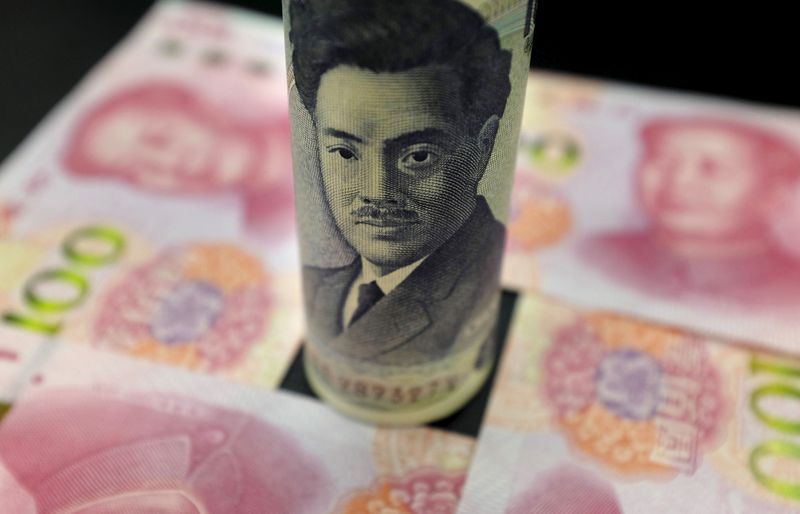

© Reuters. A Japanese 1,000 yen banknote and Chinese 100 yuan banknotes are seen in this picture illustration in Beijing, China, January 21, 2016. REUTERS/Jason Lee/File photo
A look at the day ahead in European and global markets from Rae Wee
Markets have been betting on a dollar downturn for months on the view that U.S. rates would eventually have to fall at some point this year. Until now, that has been wishful thinking.
The yen and the yuan were the latest to fall prey to a resurgent dollar on Friday, with the Japanese currency slipping deeper into intervention territory and the breaching a key level against the greenback.
Respective authorities stepped in to defend the currencies, but their efforts were in vain.
Since the Bank of Japan’s landmark rate hike on Tuesday, the yen has fallen more than 1% against the dollar. That’s left it just a whisker away from 2022’s multi-decade low, as the highly-anticipated move had counter-intuitively sent it into free fall with traders scurrying back into popular ‘carry trades’.
Japanese government officials have kept up their verbal defence of the currency, keeping investors on their toes for any signs of intervention.
The yen’s weakness also spilled over to the yuan which weakened past the psychologically important 7.2 per dollar level on Friday and prompted state-owned banks to step in to buy the yuan for dollars.
NO END IN SIGHT
With the dollar having been in the driver’s seat for the most part of the past two years since the Federal Reserve kicked off its flurry of rate hikes, analysts had, at the end of last year, expected its rally to stall come 2024.
Yet, any fall in the greenback has so far been short lived. Its latest move lower came after the Fed this week maintained its projection for three rate cuts this year.
In less than 24 hours, however, the dollar was back in favour after a surprise rate cut from the Swiss National Bank and a dovish tilt from the Bank of England (BoE) sparked selling
in the Swiss franc and sterling for dollars.
That ramped up expectations for a June rate cut by the European Central Bank and the BoE, but less so for the Fed.
“It just doesn’t seem that there’s an automatic sense that when the Fed cuts rates, there’s got to be some dollar easing if the ECB and other central banks in the G10 in particular, are doing the same or perhaps even more,” said Rob Carnell, ING’s regional head of research for Asia-Pacific.
That’s going to mean more pain for emerging Asia, in particular, given a rising dollar pressures their currencies and makes it harder for their central banks to ease monetary policy.
Key developments that could influence markets on Friday:
– UK retail sales (February)
– Germany import prices (January)
– Reopening of 1-month, 3-month and 6-month UK government debt auctions


